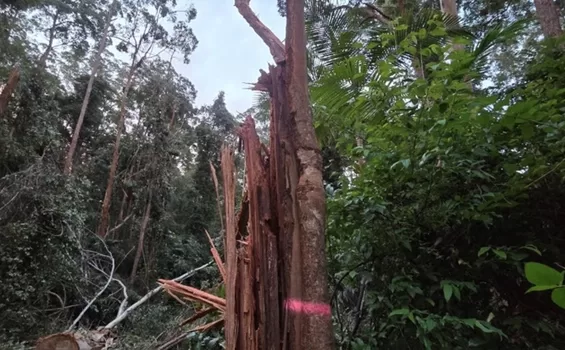The NSW Environment Protection Authority are investigating reports by locally based scientists that Forestry Corp NSW has destroyed critical koala habitat trees in Orara East State Forest, inside the proposed Great Koala National Park (GKNP).
A recent report on logging activities in Orara East State Forest, specifically Compartment 22, part of the proposed Great Koala National Park (GKNP), has revealed significant non-compliance with prescribed koala habitat protection measures.
The findings raise serious concerns about the effectiveness of forestry practices and regulatory oversight in preserving endangered koala populations.
Community groups are calling for EPA and the ALP state government to issue Stop Work Orders in Orara East State Forest and in other state forests affected by indiscriminate industrial-scale logging until the full extent of the carnage is known and adequate protections are properly in place in future.
“It is only thanks to the quick and diligent work of the community that this pre-logging survey has been revealed as unlawful and catastrophic for the koalas. The EPA needs to step up immediately,” says Greens MP Sue Higginson.
Story continues after this advertisement:
Inadequate Koala Feed Tree Retention
According to the Native Forest Map Viewer, much of Compartment 22 is designated under Koala Browse Tree Prescription 1, which requires the retention of specific koala feed trees. The harvesting plan also includes Compartment 23, which falls under the same prescription.
Despite Forestry Corporation’s voluntary commitment to retain 10 koala feed trees per hectare throughout the proposed GKNP, the report found a glaring shortfall.
The detailed analysis covered an 11-hectare sample area, centered just east of Log Dump 12 on both sides of Link Road. The study aimed to assess the average number of Koala Feed Trees (KFTs) left per hectare.
Shockingly, the report revealed an average of only 2.7 koala browse trees marked for retention per hectare, a serious breach of both the Coastal Integrated Forestry Operations Approval (CIFOA) and the voluntary measures announced by the Minister for the Environment and Forestry.
The Methods and Findings
The methodology for the study involved a systematic and thorough foot traversal of the 11-hectare area.
Using the Forestry Corporation Harvest plan and Moonee topographic maps on the “Avenza map” spatial data recording platform, all trees marked for retention were documented.
This included koala feed tree species such as Tallowwood (Eucalyptus microcorys) and Grey Gum (Eucalyptus propinqua).
Each marked tree was measured with a diameter tape and photographed, with special attention given to those showing signs of damage or death caused by logging operations.
The legal requirement for koala habitat retention across the 11-hectare area is 110 marked trees. However, only 30 koala feed trees were recorded, representing a mere 27% of the mandatory retention.
This shortfall highlights a critical failure in meeting explicit legal standards and the voluntary measures set forth by Forestry Corporation.
Undersized and Damaged Trees
The report also highlighted that several trees selected as koala browse trees were undersized. Koalas prefer trees with a diameter at breast height (DBH) greater than 30 cm, while trees 20 cm DBH or less are marginal at best.
Notably, numerous trees that would have satisfied the definition of koala browse trees, including three Tallowwood trees greater than 1 meter DBH, were logged.
Additionally, one-third of the marked koala feed trees were found to be killed, wounded, damaged, or harmed during logging operations.
This includes a severely damaged Grey Gum covered with numerous koala scratches. Specific instances included:
- A Grey Gum marked for koala habitat retention was crushed and killed during logging operations when a large Blackbutt was felled onto it.
- Three non-compliant trees were documented as being under the minimum legal size of 20 cm in diameter.
- Out of 19 marked Tallowwood koala feed trees, 8 were wounded, and one was killed.
- Two out of 11 marked Grey Gums were wounded.

Crushed/killed Grey Gum marked up for Koala Habitat retention and covered in Koala scratches.
Impact on Koala Habitat
The report underscores the severe impact of logging operations on koala habitat. The failure to adequately mark and protect koala feed trees poses a direct threat to the survival of this iconic species in logged areas.
On the Dorrigo plateau, Roberts (1997) found that larger trees, particularly Tallowwoods greater than 90 cm DBH, are highly preferred and crucial for koalas.
The abundance of koala pellets is associated with these larger trees, emphasizing the significance of preserving appropriate habitat.
Nature Conservation Council of New South Wales interactive map showing the compartments in FCNSW’s harvest plan is available here . Click layer, ‘logging since 2003′ to view a comprehensive logging history.
Expert Confirmation and Urgent Call for Action
Grahame Douglas of the National Parks Association confirmed these breaches through inspections. These violations are egregious and have likely caused serious harm to koalas within an area actively being assessed for inclusion in the Great Koala National Park.
Given the severity of the findings, there is an urgent call for an immediate Stop Work Order on Compartments 22 and 23 of Orara East State Forest while the complaint is investigated.
This measure is crucial to prevent further harm to the koala population and ensure compliance with environmental protections.
The Broader Implications
The report’s findings not only highlight specific breaches in koala habitat protection but also raise broader questions about the regulatory oversight and enforcement of environmental standards.
The Environmental Protection Agency (EPA) has undertaken to rigorously enforce all conditions, particularly those relating to koalas, yet the report indicates a failure to do so effectively.
The voluntary measures announced by the Minister for the Environment and Forestry, which were supposed to offer additional safeguards, appear to have been inadequately implemented and enforced.
The implications of these findings extend beyond the immediate area of Orara East State Forest. They call into question the overall commitment and capability of Forestry Corporation and regulatory bodies to uphold environmental laws and protect endangered species.
The proposed Great Koala National Park is intended to serve as a sanctuary for koalas, providing a safe habitat free from the threats of industrial activities.
However, the report suggests that without stringent enforcement of protection measures, the very purpose of the GKNP could be undermined.
Forestry needs an overhaul
The recent report on logging activities in Orara East State Forest, Compartment 22, serves as a stark reminder of the challenges and failures in current forestry practices and regulatory oversight.
The findings of significant non-compliance with koala habitat protection measures highlight a critical need for immediate action to safeguard endangered koala populations.
Forestry Corporation of NSW’s failure to meet legal and voluntary standards for koala feed tree retention, the damage and destruction of marked trees, and the inadequacy of regulatory enforcement by the EPA all point to systemic issues that must be addressed.
The call for an immediate Stop Work Order on Compartments 22 and 23 is a necessary step to prevent further harm and ensure that environmental protections are not merely theoretical but effectively implemented.
As the assessment for the inclusion of the Great Koala National Park continues, it is imperative that both Forestry Corporation and regulatory bodies like the EPA take meaningful steps to rectify these breaches and restore confidence in their commitment to environmental stewardship.
The survival of koalas and the integrity of their habitats depend on it.


Related stories
Logging halted after Forestry Corp misidentifies trees
Reactions to new Federal Environment Protection Agency
Forestry Corporation NSW’s Illegal Logging Exposed
Urgent Need for Transitioning to Plantation Timber
Our Gardening section
Building nesting boxes to save wildlife impacted by logging
Nesting Boxes: Creative Upcycling for Wildlife Conservation





